| The 2nd FORUM8 Design Conference |
| Overview (Up&Coming Novemer, 2008) |
Presenting Diverse Subjects on Structures from Maintenance to Natural Disasters
and Environment with Advanced Solutions
FORUM8 held the 2nd FORUM8 Design Conference at Tokyo Conference Center
Shinagawa on September 19, 2008.
FORUM8 released a 3D analysis program for space-framed structures "UC-win/FRAME (3D)" in 2002. Following this, we held the first "UC-win/FRAME (3D)
Conference" in October 2003 for the purpose of hearing opinions from
the users and presenting new products and versions. Since then, the Conference
took hold as an important event in autumn. It has been expanded since 2007,
as the "Design Conference" held in parallel with "UC-win
/ UC-1 User Conference". |
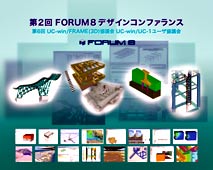 |
This year, it is planned to release "Engineer's Studio", three-dimensional
analysis CAD that has been developed as our new strategic product. A developer
of "Maekawa Concrete Model" that is supported by Engineer's Studio,
Professor Koichi Maekawa, Dept. of Civil Engineering, the University of
Tokyo gave a special lecture at the beginning of the 2nd FORUM8 Design
Conference on recent subjects relating to maintenance of concrete structures.
Technology Session was held in the afternoon, consisting of 4 main areas
of "Civil Engineering", "Architecture", "Design
CAD", and "Hydraulic Engineering" like the last time. Lectures
on the subjects set according to each area and explanation on our relevant
solutions were given in 4 different rooms, followed by sessions under the
individual subjects.
Simultaneous interpretation service in three languages (English, Japanese,
and Chinese) was provided for some of the lectures to help audience and
speakers from abroad. Moreover, TV conference system was used for participants located at Osaka, Nagoya, Fukuoka, Shanghai,
and Seoul to take part in the sessions in the main room (Hall A).
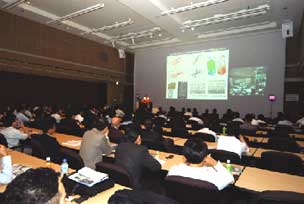 |
|
 |
 Special lecture (Large hall) Special lecture (Large hall) |
|
 Prof. Koichi Maekawa, the University of Tokyo Prof. Koichi Maekawa, the University of Tokyo |
|
 Special Lecture for Design Conference Special Lecture for Design Conference
The Conference started in Hall A at 11:00 in the morning with Sponsor's
Greetings by Yuji Ito, President of FORUM8.
Next, aforementioned Professor Koichi Maekawa from the University of Tokyo
gave the opening special lecture on "Nonlinear analysis and maintenance
of existing deteriorated RC / PC structures". Traditionally in the
performance assessment of an existing structure, resistance to earthquakes
has been a major element. Nowadays however, besides this it is more and
more required to estimate residual strength, fatigue life, or others. Focusing
on various cases that attracted attention in recent years, he explained
from the perspective of numerical analysis.
First, he listed many factors causing damage and deterioration in concrete
bridges, mentioning necessity of repair according to the patterns of damage.
Specific examples he listed included: 1) earthquake-proof repair conducted
for the pier with few problems of deterioration of steel; 2) verification
of earthquake resistance performance on the case of a railway bridge completed
over 100years before, to which seismic retrofit was applied by now after
suffering damage due to uneven settlement; 3) verification of earthquake
resistance performance on a seawater duct in an atomic power plant, on
the assumption that the structure of a complicated shape had caused critical
deformation; 4) an experiment on the residual performance of a pier when
horizontal force, torsion, and shear act at the same time. Through these
cases, he pointed out that it is important how to express cracking in concrete
and mechanical characteristics of reinforcement.
Next, with respect to the corrosion rate model of steel that "UC-win/WCOMD"
also supports, he explained the difference from the conventional model
and the advancement in simulation of steel corrosion. In specific, he made
a detailed presentation about the mechanism of how the strength rather
increases in the respective cases that the steel in the axial direction
like a beam gets corroded and has already cracks, and that of experiment
to apply shearing force to a large-scale beam with a crack previously produced
in the axial direction of the member due to thermal stress. He also mentioned
the influence of a huge earthquake on a seawater duct with steel corrosion.
Another case he explained was about the problem that alkali-aggregate reaction
occurred in a bridge structure, causing fracture of bending work in the
steel. It was a question whether it should be removed or maintained by
reinforcing. Then he introduced various kinds of examinations on impact
assessment method in a simple case, earthquake resistance performance in
the case without fixation of stirrup, impact on the structural performance
depending on the position of corrosion, and so on. He made an explanation
about some cases with numerical analysis. For example, when there is damage
in the fixed area, the situation can be worsened by repairing blindly,
while on the contrary the strength increases by covering the whole with
taping etc.
On the other hand, he said that earthquake and fatigue are only different
in the patterns such as of the number or level of loads, and that originally
nonlinear analysis technology can be applied to fatigue. It depends on
whether or not the material model can deal with the situation of high cycle,
as he explains.
Regarding this, it will be possible to deal with high-cycle cyclic stress
by adding a partial term to the traditional constitutive rule. He showed
a numerical analysis and other simulation cases by reflecting this with
a tool (UC-win/WCOMD).
In this context, Japan Society of Civil Engineers conducted calculation
to see the difference between the cases of sound situation and the situation
having damage in advance, when fatigue is applied. Compared with the case
of no damage, the case with a little damage showed obvious rapid decrease
of fatigue life. On the contrary, it was concluded that there was no significant
difference in the case of only one-time loading and deflection. He appealed
that the analysis result is open to public for the purpose of having the
third party examine its correctness by experiments.
Besides, he also mentioned verification of performance on an existing bridge
having initial degradation, forecasting of deflection and fatigue life
of the bridge superstructure against moving loads, and application cases
of analysis/simulation in design confirmation of a floating structure that
suffers salt splash and fatigue at the same time, etc. Among these studies,
he asserted that the answers would definitely be drawn as to whether the
results about durability or life are correct or not. However, since an
earthquake may not lead to verification even by monitoring for as long
as 50 or 100 years, he expects that with regard to earthquake damage, related
technology will be improved more and more by giving feedback of information
to engineers every time it is obtained.
Lastly, he again put an emphasis on the importance of an approach of developing
technology by combining estimate in the laboratory and verification based
on the reality, assuming that these cited examples were not fully verified. |
 Technology Session Technology Session
<Technology Session> started at 1:00 in the afternoon. As written
above, it was divided into four areas of "Civil Engineering",
"Architecture", "Design CAD", and "Hydraulic Engineering".
For each area, different sessions were held in each room for four hours.
The following are the points of Special Lecture, User's Special Lecture,
and presentations by the developer as well as developing groups of our
company. |
 Civil Engineering Session Civil Engineering Session |
 Geotechnical Analysis Geotechnical Analysis
Professor Keizo Ugai, Civil and Geotechnical Engineering, Gunma University
gave the first lecture of Civil Engineering Session, "Disasters in
Intermediate and Mountainous Areas Caused by Recent Inland Earthquakes
-- the Results of Research and Applications of Dynamic FEM Analysis for
2004 Chuetsu earthquake -- 2007 Chuetsu Offshore earthquake -- 2008 Sichuan
earthquake -- 2008 Iwate-Miyagi Inland earthquake". Focusing on four
earthquakes that had occurred in recent years in Japan and China, he explained
their outlines, as well as the mechanism and characteristics of earth and
soil disasters accompanied with them. He paid attention to the fact that
the case of Sichuan earthquake is characteristic of rock slope failure
on a large scale, unlike the cases in Japan in which earth and weathered
soft rock occupy the large part of the landsliding mass. He pointed out
the importance of understanding the mechanism of landslide caused by earthquake,
and mentioned that numerical simulation such as FEM is essential in order
to prove the mechanism of slope failure in more detail. Since the studies
on earthquake disasters are mainly targeted on urbanized areas, emphasis
should be put also on intermediate and mountainous areas, as he claimed.
Subsequently, FORUM8 staff introduced "GeoFEAS3D", a software
program for 3D elast-plastic analysis of ground to be newly released. This
is the successor of the existing "GeoFEAS2D" for two-dimensions.
Showing pile foundation as an example, the staff explained the operation
procedures and functions of the new product aimed for creation and analysis
of a pile group ground model. |
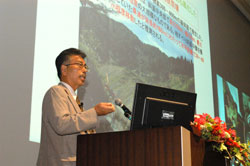
 Prof. Keizo Ukai, Gunma University Prof. Keizo Ukai, Gunma University |
 Environment and Energy Environment and Energy
Next, Professor Nobuyoshi Yabuki, Division of Sustainable Energy and Environmental
Engineering, Graduate School of Engineering, Osaka University gave a special
lecture, entitled "Computerization of Civil Engineering Improved by
Environment and Energy". He gave a commentary on computerization of
the civil engineering field in Japan from the points of view of CALS/EC,
standardization of information on construction, adoption of three dimensions
such as CAD, product models, and VR in civil engineering, and computerized
construction. He paid attention to environment and energy as keys for promoting
them. For this reason, he mentioned the different problems relating to
environment and energy, as well as the stream towards building up a low-carbon
and recycling-oriented society. He cited "national land infrastructure
model" as a solution for those problems ranging in a wide variety,
depicting the idea of cyber infrastructure based on 3D product models,
links with the actual social infrastructure, and a picture of diverse applications
for environmental and energy problems. He cited "The Third Wave"
written by Alvin Toffler as a base for these ideas, and explained the impact
that the progress of information communication technology (ICT) has on
the society. He further showed his observation that computerization of
civil engineering that had been centered on 2D drawings is going to evolve
into 3D, system integration with data models, and making the real world
intelligent by integrated simulation, with response to environmental and
energy problems as a turning point. |
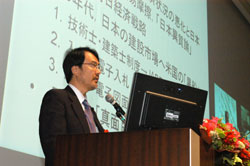
 Prof.Nobuyoshi Yabuki, Osaka University Prof.Nobuyoshi Yabuki, Osaka University |
 Bridge Design Analysis Bridge Design Analysis
As a user's special lecture, Mr. Mitsuhiro Tokuno, CEO of Asahi Engineering
Co., Ltd. gave a speech on "Examples of Design Analysis of Easy Slab
Bridges". Headquartered in Ishikawa Prefecture, the Company is a construction
consultant with bridge design occupying about 90 % of its business. He
divided easy slab bridges into simple bridges and rigid-frame bridges,
and explained the structures and applicable conditions for each type. He
further listed the characteristics of an easy slab bridge in terms of the
construction method, as follows:
1) Simple structure and low girder height
2) Supporting diverse planar structure
3) Easy construction and short work period
4) Capable of construction at a narrow and small space because of light
dead weight of the girder
5) Capable of divided execution considering existing roads at the time
of reconstruction of an existing bridge
6) Easy maintenance.
He also listed the characteristics of an easy rigid-frame bridge as follows:
1) Adopting an easy slab bridge for the superstructure
2) Improved earthquake proofness
3) Reduced size of the substructure by unifying superstructure and substructure
4) Mitigated impact on the surroundings because of minor influence of excavation.
5) Reduced cost because of no need for such devices as a bearing, an expansion
apparatus, and a falling prevention device.
With respect to the above points, our staff in charge presented the overview
of the latest development of a design calculation program for portal rigid-frame
bridges. He listed some points such as adopting a 3D model for an analysis
model and aiming at labor reduction of a person doing actual work as an
exclusive design tool. He then explained main functions and characteristics
such as scope of support, corresponding basic loads, and analysis model. |
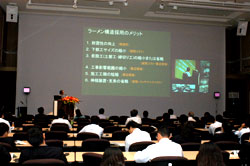
 Mr. Mitsuhiro Tokuno, Asahi Engineering Co., Ltd. Mr. Mitsuhiro Tokuno, Asahi Engineering Co., Ltd. |
 Engineer's Studio Ver.1 Engineer's Studio Ver.1
Brent Fleming, Director in charge of development in FORUM8 presented developer's
lecture on "Engineer's Studio" entitled "Presentation of
New Product - Engineer's Studio". At the opening, he listed two main
functions of Engineer's Studio as follows: 1) Mindlin plate element equipped
with Maekawa concrete model 2) user interface completely renewed. Then
he explained functions and characteristics of individual editors including
material, outline, section, frame element, spring element, and Mindlin
plate. Next, he demonstrated its operation with specific explanation about
functions ranging from table editor to copy/paste, redo/undo, and data
generation. The release of Engineer's Studio is planned within the year
of 2008. |

 Brent Fleming, Director in charge of development Brent Fleming, Director in charge of development |
|
 Architecture Session Architecture Session |
 3D Building Construction Analysis 3D Building Construction Analysis
Mr. Jason Yang, Senior Structural Engineer, Formation Design Systems Pty
Ltd. (Australia) gave developer's lecture, "Development of New Version
of Multiframe". First, he explained the overview of "Multiframe",
a 3D structural analysis program developed by the company and marketed
by FORUM8 in Japan. Next, he talked about various new functions of the
latest Ver.11 in detail with demonstration and movies. Lastly, he mentioned
the new functions to be added for the next version.
Following this, FORUM8 staff in charge of localizing foreign products gave
a presentation entitled "3D Analysis / CAD of Steel Structures --
Data Model Exchange and Latest Development", introducing the overviews
of "AdvanceSteel" (2D/3D CAD for steel structure as our solution
for steel structure-related issues), "MultiSTEEL" (simple version
of 2D / 3D CAD for steel structures), "UC-win/FRAME (3D)", "Multiframe",
and "AFES" (integrated solution for design of architecture and
plant foundation. He also explained the link of data between applications.
In addition, he mentioned "A SteelPlate" (for sheet metal girder
bridges) and "A SteelBox" (for box girder bridges), both of which
are the automatic design solutions for superstructure of steel highway
bridges (sheet metal girder bridges and box girder bridges). |

 Mr. Jason Yang, Formation Design Systems Pty Ltd. Mr. Jason Yang, Formation Design Systems Pty Ltd. |
 Home Building Cost Estimation Home Building Cost Estimation
Mr. Shuichi Yamada, Manager, Division of Architecture and Planning, Computer
System Technology Company Ltd., gave a special lecture entitled "VST5:
Supporting House Building / Renovation". "VST5" is a presentation
tool for housing developed by the company, and FORUM8 deals in it. It supports
from presentation for housing marketing to cost estimating. Its features
include rich options such as the one capable of creating 3D house models
easily. After summarizing these features, he showed the operating procedure
and such by demonstration.
Next, Forum8 staff presented "UC-win/Road for VST5", which aims
at linking this VST5 with our 3D real-time VR "UC-win/Road". This is a tool to import the house model exported by the output
function of VST5 to UC-win/Road. It is expected to bring about a number
of advantages such as capacity of reproducing the surrounding situation
of a house more realistically, covering a wide range of areas. Then, he
explained its simple procedure and presentation method through demonstration. |

 Mr. Shuichi Yamada, Computer System Technology Company Ltd. Mr. Shuichi Yamada, Computer System Technology Company Ltd. |
 BIM in Architecture / Evacuation Analysis BIM in Architecture / Evacuation Analysis
Mr. Ryuta Ieiri, Manager of "Ieiri Construction IT Lab", Planning
and Editing Committee, Construction Bureau, Nikkei Business Publications,
Inc. gave a special lecture entitled "Latest Information on BIM --
3D is Changing Construction Production Process". In his opinion, the
BIM (Building Information Modeling) model, which consists of 3D geometries
and attribute information, can be a solution for the challenges that the
construction industry have, such as improvement in productivity and CO2
reduction, based on the idea that the model serves for various uses beyond
phases. Next, he cited characteristic cases of utilizing BIM both in Japan
and the USA. In addition, he commented on what kind of added value could
be brought about to architecture design by utilizing BIM. He further stated
that a wide range of efforts and movement in introducing BIM were on progress.
Following this, FORUM8 staff presented the overviews of "EXODUS",
an evacuation analysis simulation program, and "SMARTFIRE", a
fire simulation program. Showing case studies of using them including the
one in buildings, he explained its capability of various types of simulation
and analysis. |
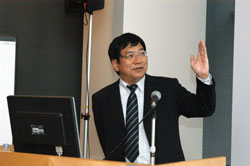
 Mr. Ryuta Ieiri, Nikkei Business Publications, Inc. Mr. Ryuta Ieiri, Nikkei Business Publications, Inc. |
 CAD for Steel Structures CAD for Steel Structures
Mr. Ulrich SCHULZE, International Marketing Application Engineer, Graitec
Inc. (France) gave a special lecture entitled "Supported BIM 3D civil
engineering and construction CAD". First, he explained its concept
from the perspective of BIM for his company, saying that utilization and
linking of data is done among different tools via one database. In addition,
he presented its diverse functions that help to improve the productivity
of "Advance Steel 2009", a CAD for 3D steel structure of the
company, including the multi-user function, with several specific cases.
Forum8 staff made a commentary on the Japanese version of "Advance
Steel". Good usability in its drawing function is remarkable, e.g.
in that a lot of members are registered by default as plug-in software
for AUTOCAD for creation of models and design documents for steel structures.
Then he went on to further explanation, showing actual procedures of operation. |
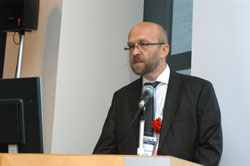
 Mr. Ulrich SCHULZE, Graitec Inc. Mr. Ulrich SCHULZE, Graitec Inc. |
|
 Design CAD Session Design CAD Session |
 UC-win/FRAME(3D) UC-win/FRAME(3D)
The Design CAD session was opened up by User's special lecture by Mr. Minoru
Maejima, Deputy Manager, Development and Sales, Bridge and Civil Engineering,
Construction Engineering Dept., Sumitomo Metal Industries, Ltd., entitled
"Examples of Aseismic Reinforcement Design of Steel Deck Arch Bridges
Using Buckling Restraint Brace". He explained examples of using UC-win/FRAME (3D) for deck arch bridges in order to evaluate aseismic capacity of existing
bridges. First, he presented the overview of the subjects, the analysis
procedure, and the actual analysis result. Then he showed the analysis
result of the case of setting up buckling restraint braces as a measure
for improving aseismic capacity as well, stating that he confirmed its
validity.
FORUM8 staff introduced the recent tendency of analysis support service
as the latest information on analysis technology of UC-win/FRAME (3D).
At the same time, he expounded on modeling and analysis procedure etc.
of river structures, bridges, or buildings with UC-win/FRAME (3D). |
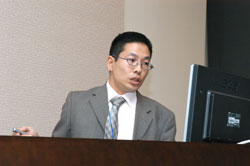
 Mr. Minoru Maejima, Sumitomo Metal Industries, Ltd. Mr. Minoru Maejima, Sumitomo Metal Industries, Ltd. |
 Substructure / Foundation Substructure / Foundation
Mr. Tomonori Sugano, Underground Construction Method Group, Division of
Foundation, Dept.of Research of Construction Technology, Takenaka Research
and Development Institute, Takenaka Corporation gave a special lecture
entitled "Design Methods Steel pipe-sheet-pile-well Foundation using
3D Frame Analysis". First, he explained the overview of steel-pipe-sheet-pile-well
foundation and its design analysis methods. Next, he expounded on the problems
of traditional methods, the reasons why 3D Frame Analysis approach did
not spread, and the necessity of 3D Frame Analysis approach. Then he mentioned
advantages of the approach, assuming the tool under joint development with
FORUM8, that it is capable of modeling a complicated structure as it is,
that it can reproduce complicated behavior accurately, that it corresponds
to flexible condition setting, and others. He also expected that it would
lead into rationalized design as well as adoption of new materials and
construction methods.
Following his speech, FORUM8 staff introduced "Design Calculation
of Steel-pipe-sheet-pile Foundation" under development. Along with
the product overview and principal characteristics, he expounded on its
specific functions while showing the operation procedure. |

 Mr. Tomonori Sugano, Takenaka Corporation Mr. Tomonori Sugano, Takenaka Corporation |
 CALS/CAD CALS/CAD
Associate Professor Etsuji Kitagawa, Faculty of Management Information,
Hannan University gave a special lecture entitled "Development of
'Logical Image', Comparison of Images". After mentioning different
types of supporting tools for electronic delivery developed by Kansai Information
Institute Co., Ltd. he belongs to, he presented one of those tools, "Logical
Image". First, he expounded on the concept of the image difference
that is a core for the tool, along with its necessity, and former existing
restrictions. Then, he explained the principal functions of Logical Image
that solved these restrictions while showing examples.
With respect to this subject, FORUM8 staff made a presentation on new products
of a CALS / CAD series. First, she explained our support to address construction
CALS aiding document information, drawing information, and electronic delivery
respectively. Then she expounded on "F8DocServ", "UC-Draw",
and "Electronic Delivery Aiding Tool Ver.8" which had reflected
the standard revision published in May this year by showing demonstration.
She also mentioned the expansion of the series implementing not only Logical
Image (for images and photos) but also Logical Smart (CAD drawings) and
Logical Document (documents). |
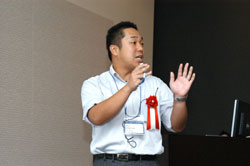
 Associate Prof. Etuji Kitagawa, Hannan University Associate Prof. Etuji Kitagawa, Hannan University |
 Civil Engineering / Temporary Work Design Civil Engineering / Temporary Work Design
To close the session, Assistant Professor Fei CAI, Social Environmental
Design Engineering Major, Graduate School of Gunma University gave a special
lecture entitled "Sheathing Work Design and Utilization of FEM Analysis".
First, he indicated the concept of the basic plan flow of soil retaining
works, and went on to explain boiling analysis, heaving analysis, and calculation
of stress and deformation based on examples of using a number of tools
including FEM analysis. He said that as a result of these, it was made
clear that 1) with conventional methods, safety factors for boiling come
to be dangerous without considering 3D effect. 2) Both 3D effect and embedment
effect are conservative without considering heaving. 3) Regarding calculation
of stress and deformation, it is important to consider that it depends
on the strain level of the deformation coefficient.
Following this, FORUM8 staff made a presentation on "Temporary Sheathing
Work Design Ver.6" supporting FEM analysis. He put a special emphasis
on the main revised points including 1) support for standard design of
land improvement projects, 2) support for hat-shaped steel sheet pile and
light-weight steel sheet pile, 3) support for concrete sheet pile, 4) support
for walls of equal thickness SMW, and 5) support for double waling. |
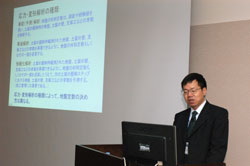
 Assistant Prof. Fei CAI, Gunma University Assistant Prof. Fei CAI, Gunma University |
|
|
 Hydraulic Engineering Session Hydraulic Engineering Session |
|
|
 The 2nd Technology Seminar on Prevention of Inundation The 2nd Technology Seminar on Prevention of Inundation
Unlike other sessions, the engineering session was held as a technology
seminar on prevention of inundation. Mr. Isao Dodo, Chairman of SWMM Users'
Association (President of Nihon Suiko Sekkei Co., Ltd) gave opening greetings. |
| First, Professor Yoshihisa Kawahara, Dept. of Social and Environmental
Engineering, Hiroshima University gave a keynote lecture entitled "Issues
and Directions of Flood Analysis in Urban Areas". He expounded on
the characteristics of torrential rains and urban flood damage in recent
years, the present situation and improvement of flood analysis technology,
the concept of the integrated flood analysis model and issues to be solved.
Through these points, he showed his observation that 1) Comprehensive flood
analysis is necessary when a torrential rain occurs; 2) For analysis considering
the urban structure, it is required to build up a inundation model in the
underground space along with acquisition of detailed data and verification;
3) It is required to analyze both networks of sewers and rivers. |
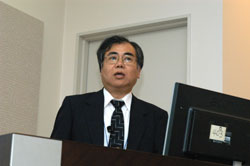
 Prof. Yoshihisa Kawahara, Hiroshima University Prof. Yoshihisa Kawahara, Hiroshima University |
| Next, Mr. Takaki Ishikawa, Water Environment Creation Club (an NPO corporation)
presented a report on ICUD (11th International Conference on Urban Discharge)
held in Edinburgh, Scotland from August 31 to September 5 this year. He
explained that discussions were made on countermeasures against climate
change, countermeasures against heavy metals and hazardous materials contained
in rains and wastewater, new technology of run-off analysis, new monitoring
technology and how to utilize it, rain forecasting with a precipitation
radar and asset management etc. He also mentioned the tasks for technology
of SWMM or Japan to be widespread throughout the world. |
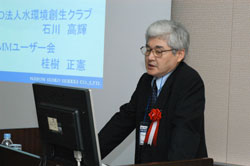
 Mr. Takaki Ishikawa, NPO Corporation "Water Environment Creation
Club" Mr. Takaki Ishikawa, NPO Corporation "Water Environment Creation
Club" |
| Professor Masaru Morita, Dept. of Civil Engineering, College of Civil Engineering,
Shibaura Institute of Technology gave a lecture entitled "From Flood
Analysis to Risk Management", with special focus on risk analysis
and risk management. Taking the Kanda River that is his own research subject
for instance, he expounded on the procedure of risk analysis, the model
for calculating flooding with inundation, and the flood damage estimation
model consisting of the aforementioned model and the model for calculating
damage based on it. Then he further made commentaries on the risk analysis
using these forecasted results and on studies of optimum flood control
measures utilizing them. |

 Prof. Masaru Morita, Shibaura Institute of Technology Prof. Masaru Morita, Shibaura Institute of Technology |
| After a break, Mr. Anthony Kuch, Vice President of XP-software Pty Ltd.
gave a lecture to introduce technology entitled "The Latest Flood
Analysis Technologies in xpswmm and Overseas Case Studies". With demonstration,
he expounded on the rain run-off analysis software "xpswmm" about
the points ranging from its superiority including linkage with GIS to capacity
of the 2D engine, integration, case studies of the model in the USA and
UK, and planned development in the future. |
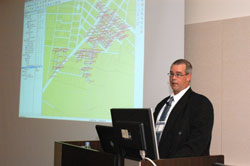
 Mr. Anthony Kuch, XP-software Pty Ltd. Mr. Anthony Kuch, XP-software Pty Ltd. |
| Next, Mr. Takehiko Naka, the First Design Section, the First Technology
Dept., Tokyo Branch, Nihon Suiko Sekkei Co., Ltd made a presentation on
case studies entitled "Evaluation of Retention Facility Against Changing
Specifications at Execution Design". He explained the overview of
the target basin for which a plan was made using xpswmm, analysis of the
present condition in the plan, the overview of the countermeasures at the
time of planning, problems that arose when the execution design was examined
in detail and the proposal of alternative measures, and the verification
of its effect. |
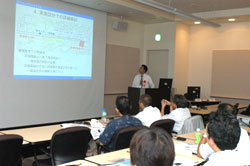
 Mr. Takehiko Naka, Nihon Suiko Sekkei Co., Ltd Mr. Takehiko Naka, Nihon Suiko Sekkei Co., Ltd |
| Another presentation on case studies was made by Mr. Yu Kikuchi, Nippon
Koei Co., Ltd., entitled "Analysis of Flushing Gate Equipped Within
Pipes and Drains, Using xpswmm". He explained the efforts of using
xpswmm in order to grasp hydraulic behaviors caused by setting up a flushing
gate in a pipe or drain, as well as the effect when two or more flushing
gates are set up. It is capable of expressing hydraulic behaviors occurring
in quite a short time such as the one with a flushing gate. The effects
of setting up one or more gates were also confirmed. In future, he would
like to study not only flow velocity but also analysis of contamination
load quantity and optimization of the position and number of the gates. |

 Mr. Yu Kikuchi, Nippon Koei Co., Ltd., Mr. Yu Kikuchi, Nippon Koei Co., Ltd., |
 Hydraulic Engineering Design Hydraulic Engineering Design
Following the lectures in the hydraulic engineering session, FORUM8 staff
made a presentation entitled " Introduction of UC-win/Road for xpswmm
and Approach to Tsunami Analysis". Showing related images, the staff
explained the tool for incorporating the data obtained through xpswmm into
UC-win/Road and visualizing them. In addition, he presented examples of
utilizing it for Tsunami analysis.
Finally, another Forum8 staff made a presentation entitled "Hydraulic
Engineering Series and Functions of Sewage CAD", introducing the overviews
of design support software products for water supply / sewage and river
design, including "Pipe network design", "Distribution basin
earthquake resistant design calculation", "Storage pond / Treatment
pond calculation", "Box culvert design (earthquake-proof sewage
system)", "Manhole design calculation", "iPipe sewerage
design CAD system", and "Flexible structure sluiceway design".
After all the lectures were over, a reception was held to help participants
to get acquainted, having a large number of attendants. We would like to
express our hearty thanks to everyone again for sharing this significant
opportunity. |
|





